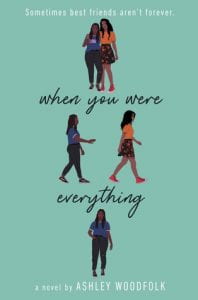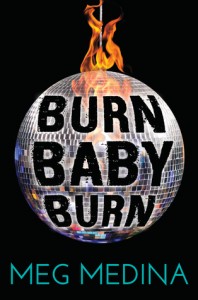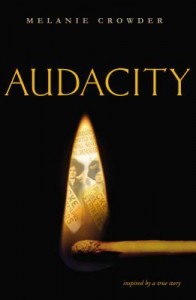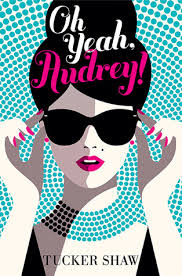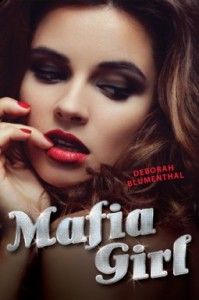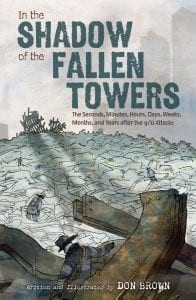 Brown, Don. In the Shadow of the Fallen Towers: The Seconds, Minutes, Hours, Days, Weeks, Months, and Years after the 9/11 Attacks. Etch / Houghton Mifflin Harcourt Books for Young Readers. 2021. 978-0-358-22357-3. 121 p. $21.99. Grades 6-9.
Brown, Don. In the Shadow of the Fallen Towers: The Seconds, Minutes, Hours, Days, Weeks, Months, and Years after the 9/11 Attacks. Etch / Houghton Mifflin Harcourt Books for Young Readers. 2021. 978-0-358-22357-3. 121 p. $21.99. Grades 6-9.
Don Brown excels at creating graphic nonfiction that introduces pivotal events in U.S. history to young readers. His previous titles explore the 1918 flu pandemic, the Dust Bowl, Hurricane Katrina, and more. Now, with the twenty-year mark approaching, In the Shadow of the Fallen Towers captures the tragedy, heroism, and aftermath of the September 11, 2001, terrorist attacks in New York City, Washington D.C., and Pennsylvania. Panels depicting the day of the attacks feature chalky, muted tones that represent the ash covering “Ground Zero” and the smoky hallways of the Pentagon. Bright orange flames also appear throughout. Expository text accompanies the artwork, along with first-person speech bubbles from eyewitnesses, first responders, George W. Bush, soldiers, and survivors. As the subtitle suggests, the author’s timeline incorporates the months and years after 9/11, including the grim victim recovery efforts, the massive clean-up, and the invasion of Afghanistan. Highly controversial topics, such as “enhanced interrogation” of suspected terrorists, are also briefly mentioned.
THOUGHTS: Don Brown’s books leave readers wanting to know more, which is a good thing; they are introductory overviews of events that will hopefully lead young readers to further, more comprehensive sources.
973 American History Amy V. Pickett, Ridley SD
Graphic Nonfiction
Don Brown has done a fine job of bringing to light current events and injustices through his graphic expository non-fiction works (Hurricane Katrina, Syrian refugee crisis). In the Shadow of the Fallen Towers is no exception. With his characteristic realistic monochromatic drawing style, he sketches out the horror of the terrorist attack on September 11, 2001, for a generation who have not lived through it. The action at the start relies heavily on what took place, rather than the cause. Brown takes the readers through the first strikes, the search and rescue and recovery efforts, and the United States government’s retaliation for the attacks. When possible, he names significant people to the event, like the film-maker Jules Naudet, who just happened to be creating a documentary on firefighters that fateful day. The author relates the courage and anxiety of the first responders, the survival and deaths of the victims, and the anguish of their families. He mentions the attacks on the Pentagon and the crash in Shanksville, Pennsylvania, but goes into more detail for his title theme. In brief, easily understandable prose, Brown describes President Bush’s and the American government’s decision to retaliate against al-Qaeda, the agency they believe to be responsible for the attacks. Throughout, the author remains objective and factual, whether reporting on the inhumane torture of the government’s main suspect in an effort to find Osama bin Laden or in the inconclusive report of “weapons of mass destruction.” The book includes the rebuilding of Ground Zero and the year anniversary memorial. In an afterword, Brown records information about America’s embroilment in a war against the Taliban in Afghanistan, the capture of Osama bin Laden in 2011, and lists of statistics on those involved in the tragedy at the World Trade Center. This carefully researched, concise report on 9/11 and its aftermath would be an apt companion to Alan Gratz’s Ground Zero, a fictionalized account of the attack on the Twin Towers. Though it tells of a horrific event in American history, it also shows the resilience, hope, and kindness of humanity.
THOUGHTS: Brown’s even-handed approach to the 9/11 tragedy and his insertion of human connections (like the names of the police officers buried and the photo of a missing victim) make this book both factual and poignant. Even younger readers can grasp what happened in this graphic text, and older readers can use the extensive source notes to nudge them to find out more.
Graphic Nonfiction Bernadette Cooke, SD Philadelphia
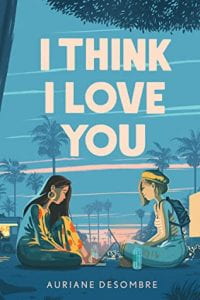 Desombre, Auriane. I Think I Love You. Underlined, 2021. 978-0-593-17976-5. $9.99. 309 p. Grades 9 and up.
Desombre, Auriane. I Think I Love You. Underlined, 2021. 978-0-593-17976-5. $9.99. 309 p. Grades 9 and up.

